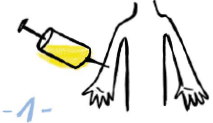Download latest issue and all issues in the archive as a PDF
PET

Positron emission tomography (PET) is a medical examination method. It makes metabolic processes in body, thus providing information about tumours or inflammations.
How it works

Characteristic
This is what a PET scan of the brain looks like. Standard PET devices measure with an accuracy of about 4 millimetres. More precise results can be obtained by combining PET with computed tomography (CT), an X-ray technique. Metabolic activity correlates with colour intensity
What is Jülich doing with PET?
- Understanding basic functions of the brain, such as the sleep process
- Improving the detection of brain tumours
- Studying diseases such as schizophrenia
- Developing new tracers
- Technically advancing the PET
This text is published in the effzett issue 1-19. Illustrations: Diana Köhne
Never miss an issue of effzett again
More Knowing it all
Loading
Last Modified: 14.03.2025





